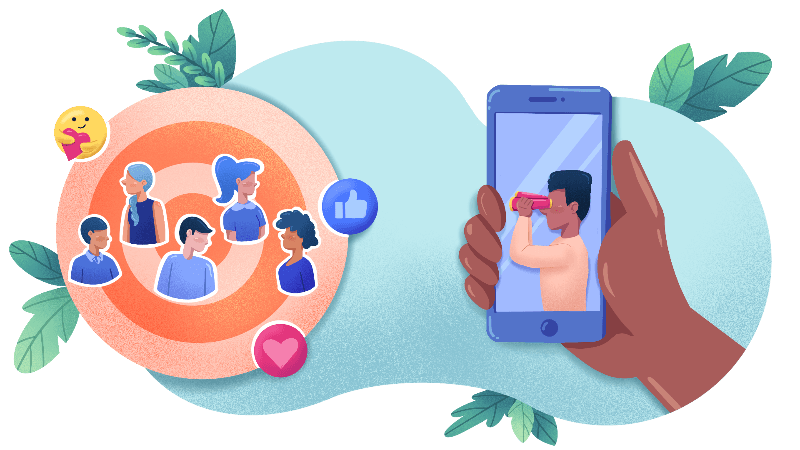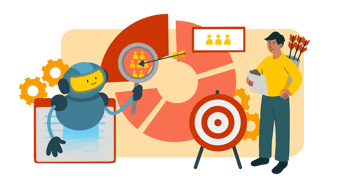Ce este Customer Lifetime Value (CLV) și cum o pot maximiza?
Gândiți-vă la clientul dvs. ideal: nu doar un cumpărător unic, ci un fan pe viață. Customer Lifetime Value (CLV) se concentrează pe valoarea totală pe care un client o aduce afacerii dumneavoastră, nu doar pe vânzarea inițială. Înțelegând și maximizând CLV, puteți transforma clienții în susținători loiali, sporindu-vă profitul și construind o afacere prosperă.

Ce este Customer Lifetime Value?
Customer Lifetime Value (CLV) este venitul total anticipat pe care un client este de așteptat să îl genereze pe parcursul întregii sale relații cu o întreprindere. CLV este metrica financiară care prognozează veniturile totale pe care un client le va genera în timpul relației sale cu o companie. Spre deosebire de concentrarea pe tranzacțiile pe termen scurt, CLV privește în perspectivă, recunoscând valoarea durabilă pe care fiecare client o aduce în timp.
Cu toate acestea, este mai mult decât o măsură financiară; este o lentilă strategică care oferă o perspectivă profundă asupra loialității și fidelizării clienților și asupra stării generale de sănătate a relației client-întreprindere.
De ce este importantă Customer Lifetime Value?
Aceasta permite întreprinderilor să anticipeze valoarea viitoare a clienților. Companiile care dispun de informații despre CLV pot lua decizii în cunoștință de cauză cu privire la alocarea resurselor de asistență pentru clienți, strategia de marketing inbound și inițiativele actuale de implicare a clienților. Aceasta oferă baza pentru o planificare pe termen lung personalizată și eficientă, asigurând că fiecare mișcare se aliniază cu obiectivul de a dezvolta relații durabile cu clienții. Îmbunătățește semnificativ înțelegerea nivelului justificabil al costurilor de achiziție a clienților.
Costurile pentru a atrage un client nou sunt de 5 până la 25 de ori mai mari decât pentru a păstra un client existent, iar 67% dintre clienții existenți generează cheltuieli mai mari decât noii clienți.
Pentru a debloca puterea CLV, întreprinderile trebuie mai întâi să înțeleagă calculul său. Formula implică înmulțirea valorii medii de cumpărare, a frecvenței de cumpărare și a duratei de viață a clientului. Această ecuație simplă generează o cifră care reprezintă valoarea potențială a unui client în timp.
Calcularea valorii pe durata de viață a clientului
Formula Customer Lifetime Value implică înmulțirea a trei componente cheie - valoarea medie a achiziției (APV) sau valoarea medie a comenzii, frecvența achizițiilor (PF) și durata de viață a clientului (CL). Formula de calcul a duratei de viață a clientului generează o cifră care reprezintă veniturile anticipate pe care un client le va genera pe parcursul întregii sale relații cu o întreprindere.
CLV = APV x PF x CL
Primul element al formulei, APV, se referă la suma medie cheltuită de un client într-o singură tranzacție. Întreprinderile pot obține această valoare prin analizarea datelor istorice, oferind o bază de referință pentru modelele de cheltuieli ale clienților.
Al doilea factor, PF, cuantifică frecvența cu care un client cumpără într-un anumit interval de timp. Această componentă recunoaște importanța afacerilor repetate și a loialității, subliniind importanța păstrării clienților pentru un succes susținut.
Elementul final, CL, reprezintă durata anticipată a relației client-întreprindere. Această durată nu este arbitrară, ci se bazează pe date istorice, analiza comportamentului clienților și dinamica pieței. Înțelegerea duratei de viață a unei relații cu clienții este esențială pentru proiectarea impactului pe termen lung asupra veniturilor.
Exemplu de Customer Lifetime Value
Să luăm, de exemplu, o cafenea. Dacă o persoană cheltuiește în medie 5 USD la fiecare vizită, vine de două ori pe săptămână și rămâne client fidel timp de cinci ani, valoarea CLV se poate determina înmulțind aceste variabile. Astfel, obținem o cifră esențială care poate ghida deciziile strategice menite să maximizeze valoarea pe termen lung a fiecărui client.
Valoare medie a achiziției (APV): 5 USD per vizită
Frecvența achiziției (PF): De două ori pe săptămână
Durata relației cu clientul (CL): Cinci ani
CLV = 5 x 2 x 5
CLV = 50 USD
În acest exemplu, CLV pentru un client al cafenelei este calculată la 50 de dolari. Aceasta înseamnă că, în medie, cafeneaua poate anticipa venituri de 50 de dolari de la fiecare client pe parcursul relației lor de cinci ani. Se iau în considerare cheltuielile clientului pe vizită, frecvența vizitelor pe săptămână și durata anticipată a relației sale cu cafeneaua.
Implicații strategice pentru relațiile existente cu clienții
-
Alocarea resurselor: Cafeneaua poate aloca resursele în mod eficient pe baza valorii anticipate pe termen lung a fiecărui client.
-
Strategii de retenție: Recunoscând importanța fidelității clienților (reflectată în frecvența și durata de viață a achizițiilor), cafeneaua poate pune în aplicare strategii de fidelizare specifice pentru a menține clienții implicați și satisfăcuți.
-
Concentrarea pe marketing: Adaptarea eforturilor de marketing pentru a încuraja afacerile repetate și a promova loialitatea devine crucială, deoarece CLV subliniază importanța cultivării relațiilor pe termen lung.
Strategii de creștere a valorii pe durata întregii vieți a clientului
Valoarea pe durata de viață a clienților nu este doar o măsură; este o busolă care ghidează întreprinderile către orizontul unui succes susținut. Elaborarea și punerea în aplicare a unor strategii eficiente reprezintă cheia deblocării întregului potențial al CLV, asigurându-se că fiecare relație cu clienții contribuie semnificativ la creșterea pe termen lung a afacerii.
Fidelizarea și retenția clienților
Piatra de temelie a CLV constă în fidelizarea și păstrarea clienților. Întreprinderile care cultivă o bază de clienți loiali beneficiază de afaceri repetate și de comentariile pozitive pe care le generează adesea clienții loiali. Păstrarea clienților pentru perioade îndelungate le sporește valoarea pe întreaga durată de viață, deoarece fiecare tranzacție contribuie în mod incremental la veniturile totale generate.
Calitatea interacțiunilor cu clienții
Natura și calitatea interacțiunilor dintre o întreprindere și clienții săi sunt esențiale în determinarea CLV. Interacțiunile pozitive și semnificative, fie printr-o comunicare personalizată, un serviciu clienți eficient sau o experiență de cumpărare fără cusur, sporesc satisfacția clienților. Clienții mulțumiți sunt mai susceptibili de a rămâne loiali și de a-și crește valoarea pe durata vieții pentru întreprindere.
Satisfacția față de produs sau serviciu
Satisfacția clienților cu privire la produs sau serviciu este un factor fundamental care influențează CLV. Un client mulțumit nu numai că este probabil să facă achiziții repetate, dar poate, de asemenea, să exploreze alte oferte din partea întreprinderii. Înțelegerea și abordarea nevoilor clienților, asigurarea calității produselor sau serviciilor și căutarea activă de feedback contribuie la o experiență pozitivă a clienților, care se traduce prin creșterea CLV.
Personalizarea și experiența clienților
Adaptarea experienței clienților prin personalizare poate avea un impact semnificativ asupra CLV. Întreprinderile care își înțeleg clienții în mod individual, oferind recomandări personalizate, oferte exclusive și o călătorie fără întreruperi, promovează o conexiune mai profundă. Personalizarea creează un sentiment de valoare, făcând clienții mai predispuși să își continue relația cu brandul pe termen lung.
Inițiative strategice de marketing
Eficacitatea inițiativelor de marketing joacă un rol esențial în modelarea CLV. Eforturile strategice de marketing care vizează publicul potrivit, utilizează informații bazate pe date și se concentrează pe fidelizarea clienților contribuie la maximizarea CLV. Acestea includ campanii specifice, programe de fidelizare și stimulente care încurajează repetarea activității și loialitatea față de marcă.
Tehnici de up-selling și cross-selling
Încurajarea clienților să exploreze produse sau servicii suplimentare prin upselling și cross-selling poate avea un impact pozitiv asupra CLV. Prin înțelegerea preferințelor clienților și sugerarea de oferte complementare, întreprinderile sporesc valoarea tranzacțiilor individuale și adâncesc angajamentul clienților față de marcă.
Segmentarea clienților
Segmentarea eficientă a clienților permite întreprinderilor să își adapteze abordările în funcție de diferitele profiluri ale clienților. Prin înțelegerea nevoilor și preferințelor unice ale segmentelor distincte de clienți, întreprinderile pot pune în aplicare strategii specifice care să rezoneze cu grupuri specifice, maximizând CLV-ul general.
Luare de decizii bazată pe date
Utilizarea datelor pentru luarea deciziilor în cunoștință de cauză este parte integrantă a optimizării CLV. Întreprinderile care utilizează analiza datelor pentru a înțelege comportamentul, preferințele și tendințele clienților pot lua decizii strategice care se aliniază nevoilor în continuă evoluție ale bazei lor de clienți. Această abordare bazată pe date asigură că întreprinderile rămân agile și receptive pentru a maximiza CLV.
Provocări în strategiile CLV
Deși CLV este imperativul strategic al unei întreprinderi, navigarea pe această cale este o provocare.
-
Trecerea cu vederea a satisfacției clienților: Una dintre cele mai frecvente capcane este ignorarea importanței fundamentale a satisfacției clienților. CLV nu se referă doar la maximizarea veniturilor, ci și la construirea de relații durabile. Întreprinderile care prioritizează câștigurile pe termen scurt în detrimentul satisfacției clienților riscă să erodeze însăși fundația CLV - clienții loiali și mulțumiți.
-
Neglijarea importanței acurateței datelor: în domeniul CLV bazat pe date, acuratețea este primordială. Bazarea pe date inexacte sau învechite poate conduce la strategii greșite, afectând precizia calculelor CLV și luarea deciziilor ulterioare. Validarea și actualizarea periodică a surselor de date este esențială pentru menținerea integrității strategiilor CLV.
-
Concentrarea exclusivă asupra câștigurilor pe termen scurt: CLV este în mod inerent o măsură axată pe valoarea pe termen lung pe care o aduce fiecare client. Întreprinderile care acordă prioritate câștigurilor pe termen scurt pot implementa strategii care generează venituri imediate, dar nu reușesc să promoveze relații durabile cu clienții. O concentrare îngustă asupra câștigurilor rapide poate compromite durabilitatea eforturilor de optimizare a CLV.
-
Ignorarea feedback-ului clienților: Preferințele și feedback-ul clienților sunt indicatori inestimabili ai satisfacției și loialității. Neglijarea căutării și încorporării în mod activ a opiniilor clienților în strategiile CLV poate duce la o neconcordanță între eforturile de afaceri și așteptările clienților. Ascultarea clienților asigură faptul că strategiile rămân relevante și corespund nevoilor lor în continuă evoluție.
-
Ignorarea dinamicii pieței: Dinamica pieței este în continuă schimbare și este influențată de factori externi, cum ar fi schimbările economice, tendințele industriei și acțiunile concurenților. Strategiile CLV care nu țin seama de contextul mai larg al pieței riscă să devină caduce. Întreprinderile trebuie să rămână atente la dinamica pieței, ajustând strategiile CLV în consecință pentru a rămâne adaptabile și competitive.
-
Neadaptarea: Pe măsură ce tehnologia evoluează, ar trebui să evolueze și strategiile CLV. Întreprinderile care nu reușesc să se adapteze la progresele tehnologice riscă să rămână în urmă în cursa pentru implicarea și satisfacția clienților. Adoptarea tehnologiilor inovatoare îmbunătățește procesul decizional bazat pe date și deschide căi pentru interacțiuni personalizate și eficiente cu clienții.
Îmbunătățiți Customer Lifetime Value pentru un succes susținut
Valoarea pe durata de viață a clientului (CLV) este firul de aur care leagă relațiile de lungă durată cu clienții și creșterea susținută a afacerii. Dincolo de simple măsurători financiare, CLV întruchipează esența strategiilor de marketing centrate pe client, care se extind dincolo de tranzacțiile individuale.
Fundamentul maximizării CLV este prioritizarea satisfacției clienților. Acest lucru, combinat cu o abordare de marketing bazată pe date, va conduce afacerea dvs. la clienți fideli, care revin. Nu uitați: CLV nu înseamnă doar dobândirea de clienți și realizarea de vânzări; este vorba despre cultivarea relațiilor pentru păstrarea și relațiile continue cu clienții.
Acest conținut este disponibil și în:
- Germană: Was ist der Customer Lifetime Value (CLV) und wie maximiere ich ihn?
- Engleză: What is Customer Lifetime Value (CLV), And How Do I Maximize it?
- Spaniolă: ¿Qué es CLV (Valor de Vida del Cliente) y Cómo Maximizarlo?
- Franceză: Qu'est-ce que la CLV et comment puis-je la maximiser?
- Italiană: Che cos'è il Customer Lifetime Value (CLV) e come massimizzarlo?
- Chineză: 什么是客户终身价值 ? 我该如何使其最大化?

Joachim, un Trainer HubSpot certificat cu peste 13 ani de experiență în Content Marketing, Strategie, implementare de website-uri și SEO, a implementat numeroase proiecte de growth marketing internaționale la scară largă, de exemplu, cu UiPath de la stadiul de startup până la listarea la bursa NYSE (IPO). Joachim are o expertiză deosebită în proiecte de Marketing multilingv și Sales Enablement, valorificând pentru clienții noștri cele mai avansate tehnologii de inteligență artificială (AI).








Lasă un comentariu cu părerea ta.